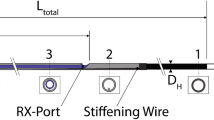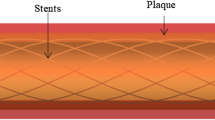Abstract
Purpose
During percutaneous coronary intervention (PCI), the ability to navigate a catheter without causing injury to the vessel and damage to the device is crucial outcome of the procedure. This study aimed to develop a numerical model to analyse the percutaneous transluminal coronary angioplasty (PTCA) catheter navigation in coronary vessels.
Methods
Trackability and pushability are two major parameters used to characterize the navigation of PTCA balloon catheters, and they are influenced by vessel tortuosity, contact interactions and catheter design. In the current study, finite element analysis model is presented to evaluate trackability and pushability considering two different vessel geometries. Impact of contact interactions among catheter, guidewire, and vessel were studied to validate the numerical model with in vitro test data. Further, a parametric study was conducted to understand the influence of distal shaft, and proximal shaft outer diameter.
Results
Obtained results suggest that contact interaction and co-efficient of friction between guidewire and catheter are critical parameters to obtain numerical results comparable to experimental data. Results from the parametric study predicted strong positive correlation of distal shaft diameter on pushability, and weak correlation on trackability force. Furthermore, parametric variation in proximal shaft diameter has strong positive correlation on trackability force and strong negative correlation on pushability.
Conclusion
Numerical methodology presented in this study is a preliminary attempt to simulate the behavior of PTCA balloon catheter navigation. This methodology will be helpful in the design and optimization of PTCA balloon catheter and similar devices with improved deliverability.


















Similar content being viewed by others
References
Anderson, J. H., and R. Raghavan. A vascular catheterization simulator for training and treatment planning. J. Digit. Imaging. 1998. https://doi.org/10.1007/BF03168278.
Boyden, B. G., A. Nilajkar, and C. J. O’Neil. The effects of type and loading of radiopaque fillers on the properties of polyether block amide compounds. Plast. Eng. 2013. https://doi.org/10.1002/j.1941-9635.2013.tb01067.x.
Bukala, J., P. Kwiatkowski, and J. Malachowski. Numerical analysis of stent expansion process in coronary artery stenosis with the use of non-compliant balloon. Biocybern. Biomed. Eng. 2016. https://doi.org/10.1016/j.bbe.2015.10.009.
Cai, Y. Y., C.-K. Chui, X. Ye, J. H. Anderson, K.-M. Liew, and I. Sakuma. Simulation-based virtual prototy** of customized catheterization devices. J. Comput. Inf. Sci. Eng. 2004. https://doi.org/10.1115/1.1705667.
Cantor, W. J., C. Lazzam, E. A. Cohen, K. A. Bowman, S. Dolman, K. Mackie, M. K. Natarajan, and B. H. Strauss. Failed coronary stent deployment. Am. Heart J. 1998. https://doi.org/10.1016/s0002-8703(98)70168-1.
Chalon, A., J. Favre, B. Piotrowski, V. Landmann, D. Grandmougin, J.-P. Maureira, P. Laheurte, and N. Tran. Contribution of computational model for assessment of heart tissue local stress caused by suture in LVAD implantation. J. Mech. Behav. Biomed. Mater. 2018. https://doi.org/10.1016/j.jmbbm.2018.03.032.
Committee ASMH. Properties and Selection: Irons, Steels, and High-Performance Alloys. Committee ASMH, 1990. https://doi.org/10.31399/asm.hb.v01.9781627081610.
Dehghani, P., A. Mohammad, R. Bajaj, T. Hong, C. M. Suen, W. Sharieff, R. J. Chisholm, M. J. B. Kutryk, N. P. Fam, and A. N. Cheema. Mechanism and predictors of failed transradial approach for percutaneous coronary interventions. JACC Cardiovasc. Interv. 2009. https://doi.org/10.1016/j.jcin.2009.07.014.
Duratti, L., F. Wang, E. Samur, and H. Bleuler. A Real-Time Simulator for Interventional Radiology. 2008. https://doi.org/10.1145/1450579.1450602.
Finn, R., and L. Morris. An experimental assessment of catheter trackability forces with tortuosity parameters along patient-specific coronary phantoms. Proc. Inst. Mech. Eng. H. 2016. https://doi.org/10.1177/0954411915623815.
Girish, M. P., M. D. Gupta, and A. Mittal. Percutaneous retrieval of entrapped partially inflated broken coronary angioplasty balloon by modified Fogarty technique. J. Invasive Cardiol. 23(7):E173–E176, 2011.
Ho, H. H., F. H. Jafary, K. K. Loh, J. K. B. Tan, Y. W. Ooi, and P. J. L. Ong. Deliverability of integrity coronary stents in severely tortuous coronary arteries: a preliminary experience. J. Invasive Cardiol. 2012. https://doi.org/10.1016/j.amjcard.2012.01.231.
Kazmierska, K., M. Szwast, and T. Ciach. Determination of urethral catheter surface lubricity. J. Mater. Sci. Mater. Med. 2008. https://doi.org/10.1007/s10856-007-3339-4.
Kharge, J., P. Sreekumar, K. Swamy, A. Bharatha, R. T. Ramegowda, and M. C. Nanjappa. Balloon-assisted retrieval of a broken stent-delivery system. Tex. Heart Inst. J. 39(5):644–646, 2012.
Kumar, S., A. L. Innasimuthu, and J. D. Marmur. The nature and pattern of coronary stent recalls. J. Invasive Cardiol. 26(9):433–436, 2014.
Kunwar, B. K., P. Jain, and M. Ghogare. Catheter-assisted balloon-supported retrieval of a broken semi-compliant balloon from a coronary artery. J. Clin. Diagn. Res. 2017. https://doi.org/10.7860/JCDR/2017/24775.9580.
Lawton, W., R. Raghavan, S. R. Ranjan, and R. R. Viswanathan. Tubes in tubes: catheter navigation in blood vessels and its applications. Int. J. Solids Struct. 2000. https://doi.org/10.1016/S0020-7683(99)00067-0.
Li, Y., C. Shen, Y. Ji, Y. Feng, G. Ma, and N. Liu. Clinical implication of coronary tortuosity in patients with coronary artery disease. PLoS ONE. 2011. https://doi.org/10.1371/journal.pone.0024232.
Martin, D., and F. Boyle. Finite element analysis of balloon-expandable coronary stent deployment: influence of angioplasty balloon configuration. Int. J. Numer. Methods Biomed. Eng. 2013. https://doi.org/10.1002/cnm.2557.
Morris, L., P. Fahy, F. Stefanov, and R. Finn. The effects that cardiac motion has on coronary hemodynamics and catheter trackability forces for the treatment of coronary artery disease: an in vitro assessment. Cardiovasc. Eng. Technol. 2015. https://doi.org/10.1007/s13239-015-0241-y.
Nikolsky, E., L. Gruberg, S. Pechersky, M. Kapeliovich, E. Grenadier, S. Amikam, M. Boulos, M. Suleiman, W. Markiewicz, and R. Beyar. Stent deployment failure: reasons, implications, and short- and long-term outcomes. Catheter Cardiovasc. Interv. Off. J. Soc. Card. Angiogr. Interv. 2003. https://doi.org/10.1002/ccd.10543.
Prasad, A., C. S. Rihal, R. J. Lennon, H. J. Wiste, M. Singh, and D. R. J. Holmes. Trends in outcomes after percutaneous coronary intervention for chronic total occlusions: a 25-year experience from the Mayo Clinic. J. Am. Coll. Cardiol. 2007. https://doi.org/10.1016/j.jacc.2006.12.040.
Rahinj, G. B., H. S. Chauhan, M. L. Sirivella, M. V. Satyanarayana, and L. Ramanan. Numerical analysis for non-uniformity of balloon-expandable stent deployment driven by dogboning and foreshortening. Cardiovasc. Eng. Technol. 2021. https://doi.org/10.1007/s13239-021-00573-4.
Rieu, R., P. Barragan, V. Garitey, P. O. Roquebert, J. Fuseri, P. Commeau, and J. Sainsous. Assessment of the trackability, flexibility, and conformability of coronary stents: a comparative analysis. Catheter Cardiovasc. Interv. Off. J. Soc. Card. Angiogr. Interv. 2003. https://doi.org/10.1002/ccd.10583.
Schmidt, W., N. Grabow, P. Behrens, and K. P. Schmitz. Trackability, crossability, and pushability of coronary stent systems—an experimental approach. Biomed. Tech. (Berl.). 2002. https://doi.org/10.1515/bmte.2002.47.s1a.124.
Schmidt, W., and P. Lanzer. Instrumentation BT—Catheter-Based Cardiovascular Interventions: A Knowledge-Based Approach, edited by P. Lanzer. Berlin: Springer, 2013. https://doi.org/10.1007/978-3-642-27676-7_27.
Schmidt, W., P. Lanzer, P. Behrens, L. D. T. Topoleski, and K.-P. Schmitz. A comparison of the mechanical performance characteristics of seven drug-eluting stent systems. Catheter Cardiovasc. Interv. Off. J. Soc. Card. Angiogr. Interv. 2009. https://doi.org/10.1002/ccd.21832.
Sharei, H., T. Alderliesten, J. J. van den Dobbelsteen, and J. Dankelman. Navigation of guidewires and catheters in the body during intervention procedures: a review of computer-based models. J. Med. Imaging (Bellingham Wash.). 2018. https://doi.org/10.1117/1.JMI.5.1.010902.
Sharei, H., J. Kieft, K. Takashima, N. Hayashida, J. J. van den Dobbelsteen, and J. Dankelman. A rigid multibody model to study the translational motion of guidewires based on their mechanical properties. J. Comput. Nonlinear Dyn. 2019. https://doi.org/10.1115/1.4043618.
Teo, A. J. T., A. Mishra, I. Park, Y.-J. Kim, W.-T. Park, and Y.-J. Yoon. Polymeric biomaterials for medical implants and devices. ACS Biomater. Sci. Eng. 2016. https://doi.org/10.1021/acsbiomaterials.5b00429.
Trehan, V., S. Mukhopadhyay, J. C. Yusuf, U. Ramgasetty, S. Mukherjee, and R. Arora. Intracoronary fracture and embolization of a coronary angioplasty balloon catheter: retrieval by a simple technique. Catheter Cardiovasc. Interv. Off. J. Soc. Card. Angiogr. Interv. 2003. https://doi.org/10.1002/ccd.10477.
Turgut, O., A. Yilmaz, K. Yalta, B. M. Yilmaz, A. Ozyol, O. Kendirlioglu, F. Karadas, and I. Tandogan. Tortuosity of coronary arteries: an indicator for impaired left ventricular relaxation? Int. J. Cardiovasc. Imaging. 2007. https://doi.org/10.1007/s10554-006-9186-4.
Wani, S. P., S.-W. Rha, J. Y. Park, K. L. Poddar, L. Wang, S. Ramasamy, J. M. Moon, J. B. Kim, S. R. Ryu, S. Y. Shin, U.-J. Choi, C. U. Choi, H. E. Lim, J. W. Kim, E. J. Kim, C. G. Park, H. S. Seo, and D. J. Oh. A novel technique for retrieval of a drug-eluting stent after catheter break and stent loss. Korean Circ. J. 2010. https://doi.org/10.4070/kcj.2010.40.8.405.
Wu, J., H. Wang, P. Zhang, X. Ma, and Q. Hu. A preliminary real-time and realistic simulation environment for percutaneous coronary intervention. Biomed. Res. Int. 2015. https://doi.org/10.1155/2015/183157.
Acknowledgments
The authors express their sincere gratitude to the management of Sahajanand Medical Technologies Ltd. for providing motivation and support to carry out the research work.
Author Contributions
Study conception and design: MLS, MVS and LR. Acquisition of data: MLS, GBR, MVS and HSC. Analysis and interpretation of data: MLS, MVS, GBR and HSC. Drafting of manuscript: MLS. Critical revision: All authors reviewed the manuscript critically.
Funding
Not applicable.
Data Availability
Due to its proprietary nature, supporting data cannot be made publicly available and are available from the corresponding author upon reasonable request.
Consent for Publication
Not applicable.
Conflict of interest
All authors are employees of Sahajanand Medical Technologies Ltd. and report no other conflicts of interest in this work.
Ethical Approval
Not applicable.
Informed Consent
Not applicable.
Author information
Authors and Affiliations
Corresponding author
Additional information
Associate Editor Alessandro Veneziani oversaw the review of this article.
Publisher's Note
Springer Nature remains neutral with regard to jurisdictional claims in published maps and institutional affiliations.
Rights and permissions
Springer Nature or its licensor (e.g. a society or other partner) holds exclusive rights to this article under a publishing agreement with the author(s) or other rightsholder(s); author self-archiving of the accepted manuscript version of this article is solely governed by the terms of such publishing agreement and applicable law.
About this article
Cite this article
Sirivella, M.L., Rahinj, G.B., Chauhan, H.S. et al. Numerical Methodology to Evaluate Trackability and Pushability of PTCA Balloon Catheter. Cardiovasc Eng Tech 14, 315–330 (2023). https://doi.org/10.1007/s13239-022-00653-z
Received:
Accepted:
Published:
Issue Date:
DOI: https://doi.org/10.1007/s13239-022-00653-z




